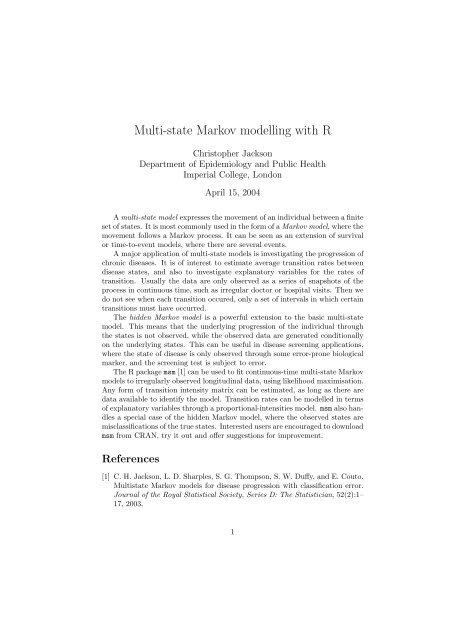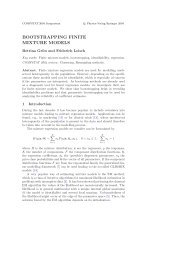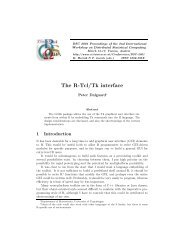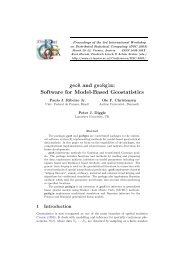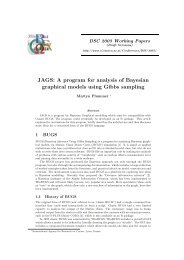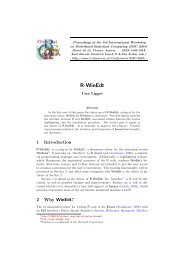Embedding R in Windows applications, and executing R remotely
Embedding R in Windows applications, and executing R remotely
Embedding R in Windows applications, and executing R remotely
Create successful ePaper yourself
Turn your PDF publications into a flip-book with our unique Google optimized e-Paper software.
Multi-state Markov modell<strong>in</strong>g with R<br />
Christopher Jackson<br />
Department of Epidemiology <strong>and</strong> Public Health<br />
Imperial College, London<br />
April 15, 2004<br />
A multi-state model expresses the movement of an <strong>in</strong>dividual between a f<strong>in</strong>ite<br />
set of states. It is most commonly used <strong>in</strong> the form of a Markov model, where the<br />
movement follows a Markov process. It can be seen as an extension of survival<br />
or time-to-event models, where there are several events.<br />
A major application of multi-state models is <strong>in</strong>vestigat<strong>in</strong>g the progression of<br />
chronic diseases. It is of <strong>in</strong>terest to estimate average transition rates between<br />
disease states, <strong>and</strong> also to <strong>in</strong>vestigate explanatory variables for the rates of<br />
transition. Usually the data are only observed as a series of snapshots of the<br />
process <strong>in</strong> cont<strong>in</strong>uous time, such as irregular doctor or hospital visits. Then we<br />
do not see when each transition occured, only a set of <strong>in</strong>tervals <strong>in</strong> which certa<strong>in</strong><br />
transitions must have occurred.<br />
The hidden Markov model is a powerful extension to the basic multi-state<br />
model. This means that the underly<strong>in</strong>g progression of the <strong>in</strong>dividual through<br />
the states is not observed, while the observed data are generated conditionally<br />
on the underly<strong>in</strong>g states. This can be useful <strong>in</strong> disease screen<strong>in</strong>g <strong>applications</strong>,<br />
where the state of disease is only observed through some error-prone biological<br />
marker, <strong>and</strong> the screen<strong>in</strong>g test is subject to error.<br />
The R package msm [1] can be used to fit cont<strong>in</strong>uous-time multi-state Markov<br />
models to irregularly observed longitud<strong>in</strong>al data, us<strong>in</strong>g likelihood maximisation.<br />
Any form of transition <strong>in</strong>tensity matrix can be estimated, as long as there are<br />
data available to identify the model. Transition rates can be modelled <strong>in</strong> terms<br />
of explanatory variables through a proportional-<strong>in</strong>tensities model. msm also h<strong>and</strong>les<br />
a special case of the hidden Markov model, where the observed states are<br />
misclassifications of the true states. Interested users are encouraged to download<br />
msm from CRAN, try it out <strong>and</strong> offer suggestions for improvement.<br />
References<br />
[1] C. H. Jackson, L. D. Sharples, S. G. Thompson, S. W. Duffy, <strong>and</strong> E. Couto.<br />
Multistate Markov models for disease progression with classification error.<br />
Journal of the Royal Statistical Society, Series D: The Statistician, 52(2):1–<br />
17, 2003.<br />
1


